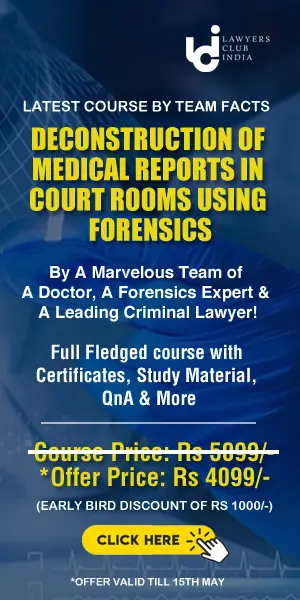Case Name:
Babu Sahebagouda Rudragoudar and Ors. Vs. State of Karnataka
Date of Order:
April 19, 2024
Bench:
J. Mehta
Parties to the Case:
Appellants- Babu Sahebagouda Rudragoudar,
Respondent – State of Karnataka
Subject:
The Hon’ble Supreme Court set aside the guilty verdict given by the high court and upheld the trial court’s verdict of acquitting the accused due to unreliable evidence and huge gaps in the case presented by the prosecution. The honorable court also sheds light upon the restrictions placed upon a court by the legal principles in case of an appeal.
Legal Provisions
- Section 48 of the Indian Penal Code, 1860, mentions the definition of “Vessel”.
- Section 143 of the Indian Penal Code, 1860, lays down the Punishment for Unlawful Assembly. It states that whoever is a member of an unlawful assembly shall be punished with imprisonment of either description for a term which may extend to six months, with a fine, or with both.
- Section 147 of the Indian Penal Code, 1860, set down the Punishment for Rioting. It states that whoever is guilty of rioting shall be punished with imprisonment of either description for a term which may extend to two years, with a fine, or with both.
- Section 149 of the Indian Penal Code, 1860, states that “Every member of unlawful assembly guilty of an offence committed in prosecution of a common object”.
- Section 302 of the Indian Penal Code, 1860, which sets down the Punishment for Murder. It states that whoever commits murder shall be punished with death or imprisonment for life and shall also be liable for a fine.
- Section 506(2) of the Indian Penal Code, 1860, details the Punishment for Criminal Intimidation which mentions “If threat is to cause death or grievous hurt, etc.”
Brief Facts
- Chanagouda (PW-1), the complainant owned agricultural land and a house in the Babanagar village situated in Karnataka.
- On the 19th of September in 2009, Chanagouda along with his son Malagounda and their laborers Revappa (PW-2), Siddappa (PW-3), Hiragappa (PW-4), and Suresh (PW-5) went to their field to build a bund.
- At around 4 pm, the accused persons A1, A2, A3, and A4 confronted Malagounda and his companions, who accused them of being guilty of murdering a person named Sangound. The accused persons stated their intent to seek revenge on Malagounda and others.
- The accused persons were also armed with weapons. A-1 was carrying a jambai (curved sword), A-2 was carrying an axe, A-3 was carrying a sickle and A-4 was carrying an axe.
- The accused persons then attacked Malagounda and killed him while simultaneously threatening chanagounda from taking any action or facing the same fate as his son. To protect himself, chanagounda ran away and hid away in the bushes.
- On the 20th of September at 04:00 AM chanagounda then registered FIR at a police station located in Tikota. After the investigation, all the accused persons were charged with sections 143, 147, 48, 302, and 506(2) of the Indian penal code.
- However, owing to the gross discrepancies in the evidence provided by the prosecution the sessions court awarded all the accused persons an acquittal.
- After the filing of an appeal by the complainants, the high court only partly upheld the sessions court’s decision whereby they convicted accused persons A-1, A-2, and A-3 whilst upholding the acquittal status of accused persons A-5 & A-6. Due to A-4 passing away the appeal against him was terminated.
- The current appeal was held against the order of the high court.
Issues Raised
- Whether the statement corroborated by the eyewitnesses enough for the aim of conviction of the appellant for the offences under sections 143, 147, 48, 506 (2), and 302 of the Indian penal code?
- Was the time difference in the time of death in the reports furnished by the medical examiner and the dishonest testimony of the investigating officers a strong basis for doubting the very reliability of the prosecution's account?
- Whether the unexplained delay in filing the FIR at the nearest police station and the contradictory statements of the eyewitnesses, a gaping hole in the prosecution’s case?
- Did the high court aptly apply the evidence and legal principles while overturning the acquittal of the accused?
Arguments Advanced for Appellants
- The appellants through their counsel forwarded the following arguments –
- The high court disregarded the established legal principles that were set forth by the sessions court regarding the appeals against acquittals.
- It was contended that the eyewitnesses did nothing to aid the now deceased and have filed fraudulent charges against the appellant due to the pre-existing enmity between the families.
- Acquittal shall only be awarded in two cases where the findings of the trial court were patently illegal or perverse. The acquittal shall only be reversed if any doubts arise about the guilt of the accused.
- It was contended that any new findings emerging from the newly conducted inquiry by the high court be dismissed. Only the evidence referred to by the trial court should be treated as evidence as entertaining new evidence goes against the principles governing the appeal application.
- It was contended that the Investigating Officer provided false testimony regarding the disclosure statements which were made by the accused and the subsequent recovery of the weapons, as the PW-1 clearly stated in his testimony that the police had shown him the weapons on the same day as the day of the incident and that neither the disclosure statement nor the recovery memo contains any signatures or thumb impressions of the accused, thus making it difficult to point the recoveries to them.
Arguments Advanced for Respondents
- Learned counsel appearing for the respondent State passionately and intensely contradicted the entries progressed by learned counsel for the appellants.
- The counsel urged that the High Court, while considering the request against acquittal, completely reappreciated the evidence accessible on record and arrived at the well-considered conclusion that the statements of the eyewitnesses PW-1, PW-2, PW-4, PW-6, and PW-15 did not endure from any critical inconsistencies.
- The FIR (Exhibit P-10) was expeditiously lodged at 4.00 am on the morning of 20th September 2001. As there was no delay in filing the FIR there was no reason for the high court to doubt the prosecution’s case.
Judgement Analysis
1. The court in the case of Babu Sahebgounda Rudragoudar & ors vs the state of Karnataka acknowledged the restrictions placed upon the court in matters of appeals especially when such appeals deal with the conviction of a previously acquitted defendant.
2. The court held that only in matters where there has been a gross misinterpretation of the evidence provided or where the guilt of the accused has been overlooked should the appellate court overturn the verdict given by the trial court.
3. The honorable Court neither found the findings of the trial court to be patently illegal nor perverse. The court upheld the findings of the trial court.
4. Citing the case of Rajesh Prasad Vs State of Bihar and Another the court dealt with the powers of the appellate court whilst dealing with an appeal against an order of acquittal and held that –
i. The appellate court needs to appreciate the evidence upon which the acquittal was founded and the Criminal Procedure Code 1973 puts a limit on the powers of the court to reach its own decision. There exist certain facts the court needs to bear in mind.
ii. In the case of an acquittal there exists a double presumption in favor of the accused. Firstly, the presumption of innocence, and secondly, the accused has once already secured an acquittal for himself.
iii. So, if the verdict of acquittal was possible because of evidence on record, the appellate court must not disturb the findings of the trial court.
5. Further, summarizing the principles that govern the principles of exercising appellate authority, the Hon’ble Court cited the case of H.D. Sundara & Ors. Vs. The state of Karnataka held that interrupting a verdict of acquittal by an appellate court can occur in three instances –
i. Wherein the judgment is patently perverse.
ii. The judgment is based upon omitted material evidence on record.
iii. Under the circumstance, where no two reasonable views are possible & the only view coherent with the guilt of the accused is based on evidence on record.
Conclusion
The apex court re-evaluated the evidence provided and struck down the verdict of the high court while upholding the verdict presented by the trial court. The apex court echoed the same sentiments of the trial court and found loopholes in the case of the prosecution. Therefore, the court freed the bail application of the defendants in the said case, thus allowing the appeal and judging any pending applications related to the case as resolved.















